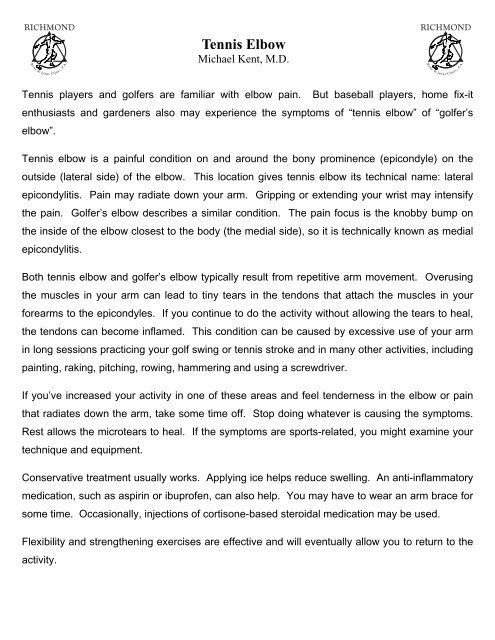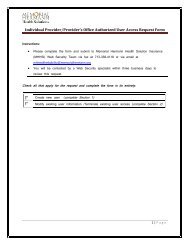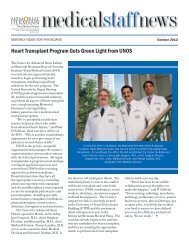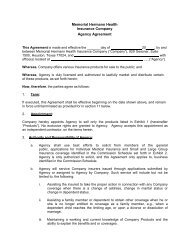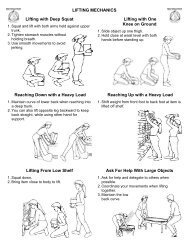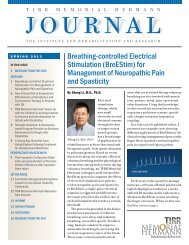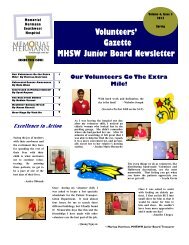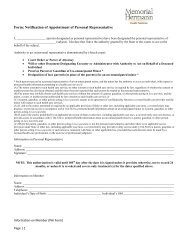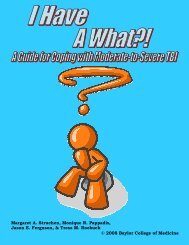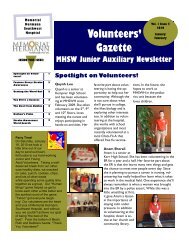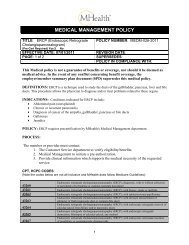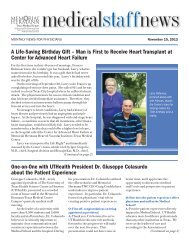Tennis & Golfer's Elbow Exercises - Memorial Hermann Medical Group
Tennis & Golfer's Elbow Exercises - Memorial Hermann Medical Group
Tennis & Golfer's Elbow Exercises - Memorial Hermann Medical Group
You also want an ePaper? Increase the reach of your titles
YUMPU automatically turns print PDFs into web optimized ePapers that Google loves.
<strong>Tennis</strong> <strong>Elbow</strong>Michael Kent, M.D.<strong>Tennis</strong> players and golfers are familiar with elbow pain. But baseball players, home fix-itenthusiasts and gardeners also may experience the symptoms of “tennis elbow” of “golfer’selbow”.<strong>Tennis</strong> elbow is a painful condition on and around the bony prominence (epicondyle) on theoutside (lateral side) of the elbow. This location gives tennis elbow its technical name: lateralepicondylitis. Pain may radiate down your arm. Gripping or extending your wrist may intensifythe pain. Golfer’s elbow describes a similar condition. The pain focus is the knobby bump onthe inside of the elbow closest to the body (the medial side), so it is technically known as medialepicondylitis.Both tennis elbow and golfer’s elbow typically result from repetitive arm movement. Overusingthe muscles in your arm can lead to tiny tears in the tendons that attach the muscles in yourforearms to the epicondyles. If you continue to do the activity without allowing the tears to heal,the tendons can become inflamed. This condition can be caused by excessive use of your armin long sessions practicing your golf swing or tennis stroke and in many other activities, includingpainting, raking, pitching, rowing, hammering and using a screwdriver.If you’ve increased your activity in one of these areas and feel tenderness in the elbow or painthat radiates down the arm, take some time off. Stop doing whatever is causing the symptoms.Rest allows the microtears to heal. If the symptoms are sports-related, you might examine yourtechnique and equipment.Conservative treatment usually works. Applying ice helps reduce swelling. An anti-inflammatorymedication, such as aspirin or ibuprofen, can also help. You may have to wear an arm brace forsome time. Occasionally, injections of cortisone-based steroidal medication may be used.Flexibility and strengthening exercises are effective and will eventually allow you to return to theactivity.
Wrist Flexor Stretch<strong>Tennis</strong> <strong>Elbow</strong> <strong>Exercises</strong>Wrist Extensor Stretch1. Straighten elbow completely.2. With palm facing up, grasp themiddle of hand and thumb.3. Pull wrist down until mild stretchis felt.4. Hold for 30 seconds.5. Release and repeat 3 times.6. Perform exercises two times eachday.1. Straighten elbow completely.2. With palm facing down, grasp theback of the hand.3. Pull wrist down until mild stretch isfelt.4. Hold for 30 seconds.5. Release and repeat 3 times.6. Perform exercises two times eachday.Wrist Extension with Weights1. The forearm should be supported on a table with handoff edge and palm should face downward.2. Using a weight, lower the hand as far as possible thencurl wrist up as high as possible.3. Repeat 30 times.4. Perform exercise one timeeach day.Wrist Flexion with Weights1. The forearm should be supported on a table with handoff edge and palm should face upward.2. Using a weight, lower the hand as far as possible thencurl wrist up as high aspossible.3. Repeat 30 times.4. Perform exercise onetime each day.Wrist Pronation with Weights1. The forearm should be supported on a table with wrist inneutral position.2. Using a weight or hammerheld in a normalhammering position, rollwrist and bring hammerinto pronation as far aspossible3. Hold for 2 seconds.4. Raise back to startingposition and repeat.Wrist Supination with Weights1. The forearm should be supported on a table with wrist inneutral position.2. Using a weight or hammerheld in a normalhammering position, rollwrist and bring hammerinto full supination as faras possible3. Hold for 2 seconds.4. Raise back to startingposition and repeat.Radial / Ulnar Deviation with Weights1. The forearm should be supported on a table with wrist inneutral position and hand off of table.2. Using a weight or hammer held in a normal hammeringposition, roll wrist andbring hammer into ulnardeviation as far aspossible.3. Then bring into radialdeviation as far aspossible.4. Raise back to startingposition and repeat.These exercises are to be performed _____ timesper week / day. Begin with 3 sets of 10 repetitionsand progress to 5 sets of 10 repetitions. Progressyour weight as tolerated (i.e.-5 sets of 10repetitions completed easily with specific weight,you will increase by 1# and decrease you exerciseto 3 sets of 10 repetitions). You will progress to 5sets of 10 repetitions again and repeat the sameprocess until you can perform 5 sets of 10repetitions with 5#. You do NOT want to exceed5# on these exercises at any time. Afterperforming your exercises, ice your wrist for 15-20minutes.


